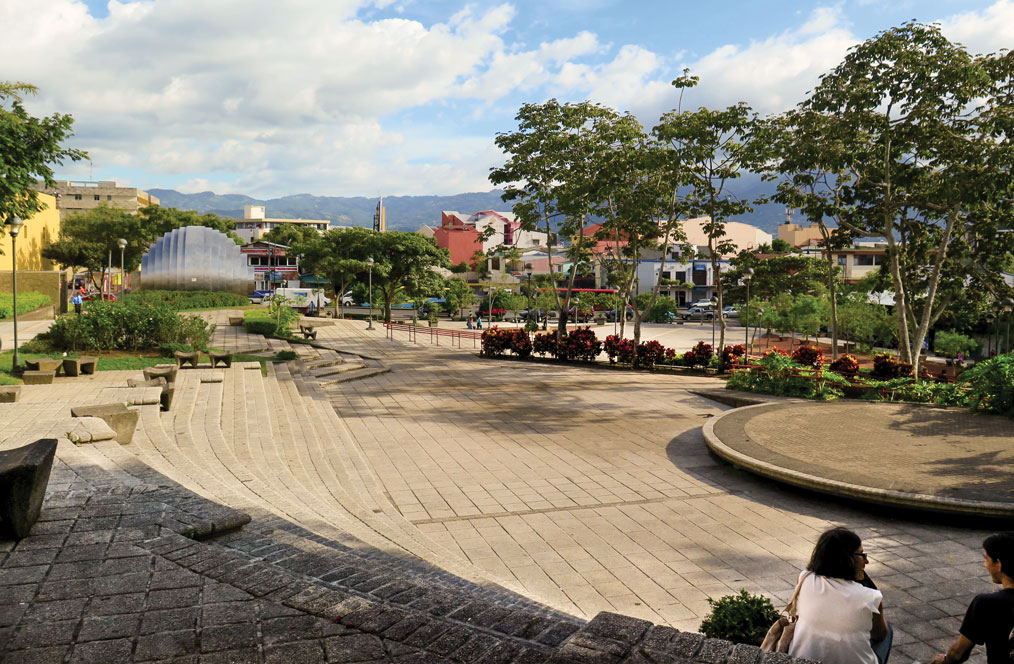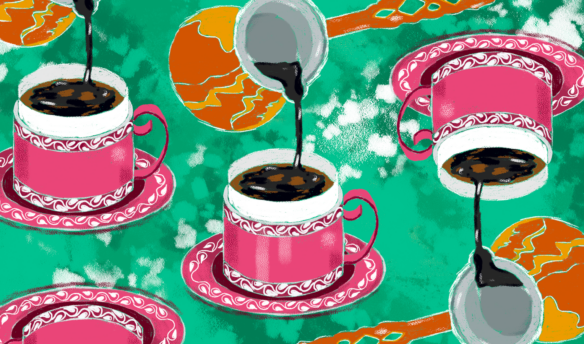San Jose’s Plaza Del Democracia (Photos: Ketti Wilhelm.)
[C]osta Rica is famous for its eight distinct coffee-growing regions—each yielding beans with unique characteristics, brewed in kitchens and coffee shops all around the world—but unknown outside its borders for having a robust coffee culture.
Almost since the first coffee seeds were planted in Costa Rican soil in 1808, the nation has been an exporter. By 1830, coffee was the country’s number one export.
At the very beginning of Costa Rica’s independence from Spain, the first president decided to incentivize coffee the way the US incentivized clear-cutting forests in the American West: anyone who cultivated a plot of land as a coffee farm for five years became owner of the land.
But Costa Rican coffee, as the world knows it, was never intended for Costa Rican use. Though coffee has long been popular among Costa Ricans, many people drink beverages brewed from lower-quality beans.
FIGHTING FOR GOOD COFFEE

“We’ve had to fight a lot to buy good coffee,” says Manuel Dinarte, explaining that most growers export everything they grow and are reluctant to sell beans locally, knowing they can get a better price abroad.
Dinarte is the country’s 2008 national barista champion, and the fast-talking owner of Café Del Barista in San José. It’s easy to imagine him putting up a fight to get the beans he wants. Dinarte’s competitive tenacity is clear to see. Francella Rodriguez Zeledón, one of the shop’s baristas, explained her boss’s standards, “Manuel says that a barista who doesn’t compete isn’t a barista.”
Dinarte’s meticulous methods are reflected in the quality of the cup. Café Del Barista served an impressive cappuccino with a rich blanket of smooth-as-silk foam and a complex, fresh flavor.
The café is casual, airy, and comfortable—not so big it feels like a warehouse, not so small it feels cramped. The two-group La Marzocco espresso machine was manned by baristas with obvious skill as well as passion for the drink.
For another of Dinarte’s baristas, Jonathan Ramirez Bravo, the small country’s coffee regions can be mapped out not by what they produce, but by what they drink. In Guanacasta, Bravo says they brew the coffee too strong. The people of Cartago serve it too hot. And anywhere you go, a café chorreado has too much sugar. Connections to coffee run deep in the shop, as do opinions.
As to Dinarte’s opinions, he considers Costa Rica’s Western Valley to be one of the world’s best coffee-growing regions, and he buys his coffee from two Herbazú micro-producers there. According to Dinarte, Costa Rica has more than 3,000 micro-producers—small, often family-owned coffee farms that sell their product only to small exporters or directly to cafés.
“Here, everyone has family members that are producers,” Dinarte said. “That’s how this generation gets involved; many baristas are the children of coffee families.”
OLD TRADITIONS, NEW LOCALES
Leda Sanchez comes from one such coffee family, as Dinarte calls them.
Sanchez is the third generation in her family to make a living in the coffee industry, but she’s the first to bring the product full-circle, back to the Costa Rican consumer. Three years ago, Sanchez started Viva Café, in an up-market neighborhood called La California. All the coffee she and her baristas prepare is roasted by her father in Cartago, a few miles east of San José.
In the past few years, Sanchez says she’s seen a transformation in San José. Neighborhoods are dotted with trendy cafés, movie theaters, and bars selling craft beer—none of which are part of the typical scene of a Central American city.
Though the cafés may be new, some traditions are not. Pre-ground robusta beans are often served using a chorreador, a thoroughly Costa Rican brewing method composed of a fine cloth filter that hangs from a sort of wooden gallows. It’s simple, functional, and perfectly capable of producing a fine cup of coffee. Café chorreado is often found in sodas, the Costa Rican version of a no-frills diner.
Some new third-wave cafés in the capital list the chorreador on their menu along with the V60 and the Chemex. At Cafeoteca, a café in San José’s Barrio Escalante neighborhood, customers can order an individually brewed cup of local-style café chorreado from any of the eight Costa Rican coffee regions. At $3.60 a cup, the price is uncommonly high, but Cafeoteca’s barista also curates the café experience, explaining aspects of the coffee including the method, the process, and the varietal.
Contrast that price with a seventy-five-cent cup from a soda, where the café chorreado is usually prepared in bulk in the morning and stored in a plastic thermos—much like the infamous drip coffee in North American diners. Most sodas even have the same utilitarian feel of the roadside diners in the US. The chorreador is to the Costa Rican soda what the drip dispenser is to the American diner: plenty of people drink it, but plenty are now looking for something new.
That search for something new, something beyond the soda, has been reflected in Tico, or Costa Rican, customers’ attitudes during the three years since Cafeoteca opened, according its manager, Evelyn León. “They’re getting more demanding,” she says. Customers now ask more questions, such as the roast date of the beans and which micro-region and farm grew them. Cafeoteca stocks twenty-three different varieties—all Costa Rican—representing all eight growing regions.
For Costa Ricans who have long known coffee to be a livelihood, Cafeoteca may be a jarring contrast. It’s a chic café with sacred few tables and prices comparable to those in the US—and the air of exclusivity is particular to the neighborhood, Barrio Escalante, a posh, low-rise, mostly residential area with a faded, tropical look, foodie restaurants, and lots of law firms.
“People are learning what coffee really is, not just, ‘I drink it and I wake up,’” says Rodrigo Muñoz, a Cafeoteca barista in a crisp button-down shirt and floor-length, black apron.
VANDOLA: A COSTA RICAN INVENTION
Another way that Costa Rica is evolving its café culture is through brewing. All three cafés—Café Del Barista, Viva Café, and Cafeoteca—offer the vandola, a device invented by Costa Rican Minor Alfaro, as a brewing method.
“We took the Chemex and changed everything we didn’t like,” Alfaro says of his creation. The changes included adding a large spout and handle to make the device more suited to professional service.
Handmade from Costa Rican clay, the vandola imparts a slightly earthy taste to the smooth feel of the brew. It’s a drip-filter method, of which Alfaro says at least 420 designs exist in the world.
The vandola’s sturdy walls and narrow top opening, which stays covered by the filter during service, keep the batch warm. A small air hole next to the handle allows ventilation. Alfaro uses a paper Chemex filter with the vandola, but he says metal and cloth filters also work. He began production early in 2016 and after selling about 350 pieces, mostly in Costa Rica, Chile, and Argentina, he hopes to soon be able to sell his product online in the US.
COSTA RICANS DRINKING COSTA RICAN COFFEE

Alfaro wants Costa Ricans to drink coffee that’s as good as what they grow. But he has little interest in adopting service styles from abroad. In addition to inventing the vandola, Alfaro owns Kaffa Café in the town of Coronado, just outside San José. Kaffa feels nothing like the bare-bones, old- fashioned sodas, nor like the bright, modern shops in the city center. The feeling is all simple, homey charm. Colorful glass lamps hang over tightly packed tables, where families meet for big lunches and strong, local coffee.
At Kaffa, cappuccinos are served the old-fashioned way—in short- stemmed, clear, tulip glasses, topped with a layer of light and fluffy bubble- bath-like foam and a heart-shaped dusting of cinnamon. Alfaro modernizes by blending tradition and innovation, without letting either take center stage.
Alfaro opened his shop in 2003, and the next year switched to buying only single-origin beans. He now buys most of his beans from the same region as Dinarte, of Café del Barista, from a farm called Finca Herbazu in the Western Valley. A budding coffee grower, he also tends his own one-acre coffee farm on a small plot of land on a hillside in town, with the goal of supplying Kaffa exclusively with his own beans. “I want people to have to come to Kaffa for our unique flavor,” he says.
“Since the first day we opened, the idea was to sell export-quality coffee,” Alfaro said. “Our interest is in Costa Ricans trying Costa Rican coffee.” Alfaro sees the lack of consumer coffee knowledge among locals and hopes to inspire change.
Perhaps it’s a look into the future of Costa Rican coffee, as a leader not only in production but also in culture.
—Ketti Wilhelm is a freelance writer based in Milan, Italy.




















